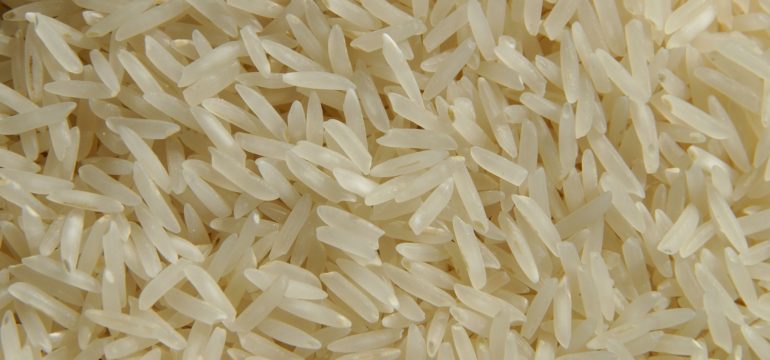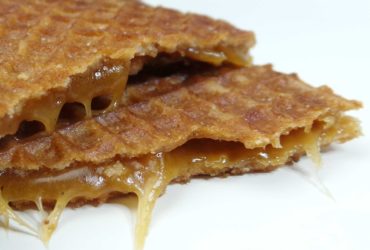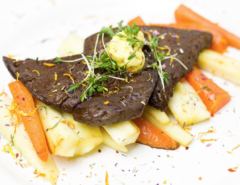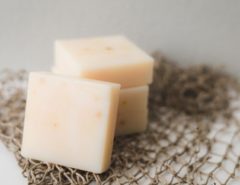By Bryan Quoc Le | www.bryanquocle.com
Koji in the Kitchen
Koji is gaining a resurgence in the amateur culinary community as people are finding new ways to apply this ancient mold culture to cooking.1 Koji is traditionally used in Oriental cuisine as a method to add flavor, by growing the mold on a grain such as rice and submerging the rice in brine to create an enzyme-rich shio-koji,2 which can be used as a seasoning or marinade that breaks down food proteins and carbohydrates into flavor-enhancing molecules. But these days, koji has been readapted and reinvented in the West as a way to boost the umami flavor of nontraditional foods without using additives. For example, Chef David Chang of the Momofuku Lab3 in Brookyln, NY has used koji to make a miso-like paste, dubbed Hozon, using sunflower seeds, pistachios, and chickpeas instead of the traditionally used soy bean. In 2013, he lectured at Harvard University’s Science & Cooking public lecture series on koji and its power to impart both sweetness and ‘umami’ to foods by breaking down the carbohydrates and proteins found naturally in foods into sugars and two umami-flavored amino acids, glutamic acid and aspartic acid. Chef Jeremey Umansky, of the delicatessen Larder in Ohio City, OH, has also experimented with using koji to rapidly age pastrami and other deli meats and create explosions of flavor in significantly less time.4 Umansky recently shared his love for koji in a TEDxCLE talk. It seems that the rise of koji is getting some serious facetime and shows no sign of slowing down.

A rib-eye rapidly dry-aged using koji-inoculated rice grains. Image Courtesy of Bon Appétit.
As I talked about koji before in my soy sauce blog post, it is a type of edible mold culture made up of mostly of Aspergillus oryzae and is used to ferment soy sauce, miso, sake, and other common Japanese fermented foods. Although other Oriential culinary traditions use their own form of a koji-like mold, the Japanese have developed sophisticated methods of inoculating, fermenting, and collecting pure strains of the mold over the centuries, which has influenced many of their culinary traditions. Unlike other Aspergillus molds, which produce the carcinogen aflatoxin, Aspergillus oryzae is safe to use in food. To use koji, mold spores of the culture, known as koji-kin, are first used to inoculate cooked grains to grow the mold.5

Koji-kin, or mold spores, being generated from rice-koji. Image Courtesy of Organic-Cultures.com.
Rice is typically used to grow koji, however, other grains have been used, such as barley, wheat, oats, and rye. The koji needs a source of carbohydrates to flourish, which can be found in these grains. As the mold flourishes, it begins to spread its mycelium into the interiors of the grain and excretes a cocktail of enzymes that break down the complex proteins and carbohydrates found in the grain.5 After two to three days of aerobic fermentation, the enzyme-rich inoculated grain is then added to meats, pastes, marinades, sauces, legumes, or other food ingredients. There, the koji and accompanying enzymes will begin to break down the macromolecules in those foods and ingredients to give an umami-bomb of glutamates and aspartates. Sugars formed from the degradation of carbohydrates will also react with these free amino acids to form flavor molecules through the Maillard reaction when the seasoned food is cooked at high heat.

Insect garum paste made from koji mold. Image Courtesy of Nordic Food Lab.
Researchers, cooks, chefs, and brewers alike are using koji grains to expand flavor profiles of recipes, ferment novel miso sauces, and even make whiskey. Members of the Nordic Food Lab team have played with roasting koji-permeated grains to create flavors ranging from soy sauce-like to chocolate, coffee, and caramel.5 The flavors are formed from the Maillard reaction between free amino acids and sugars generated from the koji digestive enzymes and initiated from roasting. They have even used koji to ferment grasshoppers and moth larvae to create a rich and distinct insect ‘fish’ sauce.6 Rich Shih of OurCookQuest.com recently outlined a way to ferment cheese and whey-based miso using koji.7 Here, he took combined ricotta with fresh koji and salt, and fermented the mixture over one month to give a strong Parmesan flavor. By combining koji and salt with whey protein, he was able to create nacho cheese-like flavor with the same procedure. Both amateur and micro-distillers are invoking the power of koji to brew alcohol for distilling. For example, members of HomeDistiller.org have experimented with using koji to convert the starches in corn into free sugars, rather than standard methods such as adding commercial amylase, that can be used by brewing yeasts to produce alcohol.8 The possibilities for koji are massive as more cooks and chefs experiment with this ancient mold.

Traditional miso paste. Image Courtesy of The Splendid Table.
While koji can be purchased at a Japanese specialty grocery store or online through companies such as GEM Cultures or Cold Mountain, there are few options for people in regions where there are no Japanese stores or these companies do not ship. As a solution, Sandor Katz, in The Art of Fermentation, outlines a way to capture koji from natural sources.9 He explains that the koji mold can be found in on fresh corn husks. Rice grains are steamed, cooled to room temperature, and wrapped in corn husks in little balls, then hung up outside under the eaves of a roof during the summer months to promote growth of the koji mold. However, this method can be risky because it’s unclear if the mold you’ve captured is indeed a safe strain of Aspergillus or a toxic form; Katz says that one should be familiar with the way freshly grown koji smells and looks before attempting this method of wild fermentation.

The Art of Fermentation by Sandor Katz. Image Courtesy of Phickle.com.
Koji has long been used to pack more flavor into foods. And while useful for adding flavor, koji has also been touted as a health-enhancing mold. The proteases and amylases released by the koji are believed to remain active in the fermented food long after the koji has begun to die. Some have suggested that these enzymes could potentially remain active after ingestion, as some of these enzymes can still function to some moderate degree in the acidic conditions of the stomach.10 Others have found that adding safely prepared koji-fermented foods to their diet helps them digest their food, as the koji pre-digests some of the carbohydrates and proteins. However, it’s still scientifically unclear if the effects of koji enzymes present in food are sufficient to help reduce any symptoms or conditions.11 Regardless, koji has made an incredible impact on Japanese cuisine, so much so that koji is celebrated as Japan’s national fungus on National Fungus Day.

Aspergillus oryzae, or koji, in the comic book series Moyashimon. Image Courtesy of AwesomeSauceEats.com
Hopefully this much beloved mold will go on to bring bolder flavors to the Western world.
Want to keep up with the conversation? Follow us on Instagram and Facebook for quick updates on seminars, events, and food science!
References
- Graber, Cynthia, “The Science of Koji.” Cook’s Illustrated. 25 Sept. 2016. Web. 28 June 2018.
- Duggan, Tara, “Traditional Japanese Koji Turns Into Versatile Seasoning.” SF Gate. 17 May 2013. Web. 28 June 2018.
- Wilder, Charlotte, “A Visit to Brooklyn: Touring the Momofuku Culinary Lab’s Kaizen Trading Company.” America’s Test Kitchen. 25 April 2017. Web. 5 July 2018.
- McKenna, Karin, “An Old-School Deli from a Fermentation Expert Opens in Cleveland.” Eater. 24 April 2018. Web. 28 June 2018.
- Evans, Josh, “Koji – history and process.” Nordic Food Lab Blog. 23 Dec. 2013. Web. 28 June 2018.
- Evans, Josh, “Fractionating insect garums.” Nordic Food Lab Blog. 18 Mar. 2016. Web. 28 June 2018.
- Shih, Rich, “Miso Method Dairy Amino Sauces.” Our Cook Quest. 2 Feb. 2017. Web. 28 June 2018.
- “Koji instead of malting?” Home Distiller Forums. 7 Sept. 2005. Web. 28 June 2018.
- Katz, Sandor, The Art of Fermentation. Hartford :Chelsea Green Publishing, 2012. Print.
- Raman, Ryan, “12 Foods That Contain Natural Digestive Enzymes.” Healthline. 15 May 2018. Web. 5 July 2018.
- Godman, Heidi, “Digestive enzymes supplements for heartburn?” Harvard Health Blog. 13 April 2018. Web. 5 July 2018.

Bryan Quoc Le | www.bryanquocle.com
IFTSA VP of Digital and Social Media (2019-2020)
Bryan is the author of 150 Food Science Questions Answered (Rockridge Press, 2020) and a Ph.D. candidate in Food Science at University of Wisconsin-Madison studying the health effects of garlic and onion flavors. He received his B.S. and M.S. in Chemistry at the University of California, Irvine. In another life, he walked 2,000 miles from California to Louisiana in six months, and learned that eating tuna and peanut butter every day was not meant for the average human body. After he met his wife, he learned that there was more to good food than canned goods and smoothies. While not juicing onions and pressing garlic, Bryan likes to run half-marathons, discover interesting cuisines with his wife, and help entrepreneurs develop great food products.






Leave a Reply